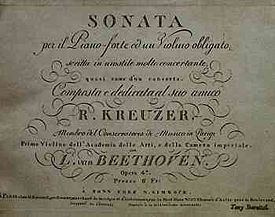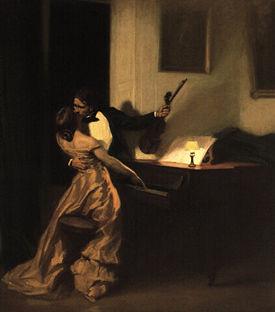
Violin Sonata No. 9 (Beethoven)
Encyclopedia


A major
A major is a major scale based on A, with the pitches A, B, C, D, E, F, and G. Its key signature has three sharps.Its relative minor is F-sharp minor and its parallel minor is A minor...
, commonly known as the Kreutzer Sonata, is a violin sonata
Violin sonata
A violin sonata is a musical composition for violin, which is nearly always accompanied by a piano or other keyboard instrument, or by figured bass in the Baroque period.-A:*Ella Adayevskaya**Sonata Greca for Violin or Clarinet and Piano...
which Ludwig van Beethoven
Ludwig van Beethoven
Ludwig van Beethoven was a German composer and pianist. A crucial figure in the transition between the Classical and Romantic eras in Western art music, he remains one of the most famous and influential composers of all time.Born in Bonn, then the capital of the Electorate of Cologne and part of...
published as his Opus 47. It is known for its demanding violin part, unusual length (a typical performance lasts slightly less than 40 minutes), and emotional scope — while the first movement is predominantly furious, the second is meditative and the third joyous and exuberant.
The sonata was originally dedicated to the violinist George Bridgetower
George Bridgetower
George Augustus Polgreen Bridgetower was an Afro-Polish-born virtuoso violinist, who lived in England for much of his life. He was born in Biala in Galicia, where his father worked for Hieronimus Wincenty Radziwill, in 1778. He was baptised Hieronimo Hyppolito de Augusto on 11 October 1778...
(1780–1860), who performed it with Beethoven at the premiere on 24 May 1803 at the Augarten Theatre at a concert that started at the unusually early hour of 8:00 am. Bridgetower sight-read the sonata; he had never seen the work before, and there had been no time for any rehearsal. However, research indicates that after the performance, while the two were drinking, Bridgetower insulted the morals of a woman whom Beethoven cherished. Enraged, Beethoven removed the dedication of the piece, dedicating it instead to Rodolphe Kreutzer
Rodolphe Kreutzer
Rodolphe Kreutzer was a German violinist, teacher, conductor, and composer of forty French operas.-Biography:...
, who was considered the finest violinist of the day. However, Kreutzer never performed it, considering it "outrageously unintelligible". He did not particularly care for any of Beethoven's music, and they only ever met once, briefly.
Sources suggest the work was originally titled "Sonata mulattica composta per il mulatto Brischdauer [Bridgetower], gran pazzo e compositore mulattico" (Mulatto Sonata composed for the mulatto Brischdauer, big wild mulatto composer), and in the composer's 1803 sketchbook, as a "Sonata per il Pianoforte ed uno violino obligato in uno stile molto concertante come d’un concerto".
Structure
The piece is in three movementsMovement (music)
A movement is a self-contained part of a musical composition or musical form. While individual or selected movements from a composition are sometimes performed separately, a performance of the complete work requires all the movements to be performed in succession...
, and takes approximately 43 minutes to perform:
- Adagio sostenuto - Presto - Adagio (about 15 minutes in length)
- Andante con variazioniVariation (music)In music, variation is a formal technique where material is repeated in an altered form. The changes may involve harmony, melody, counterpoint, rhythm, timbre, orchestration or any combination of these.-Variation form:...
(about 18 minutes) - Presto (about 10 minutes)
The sonata begins with a slow chordal introduction in the major played by the violin. The piano enters, and the harmony begins to turn darker towards the minor, until the main body of the movement—an angry A minor Presto—begins. Here, the piano part matches the violin's in terms of difficulty. Near the end, Beethoven brings back part of the opening Adagio, before closing the movement in an anguished coda.
There could hardly be a greater contrast with the second movement, a placid tune in F major followed by five distinctive variations. The first variation transliterates the theme into a lively triple meter while embellishing it with trills, while in the second the violin steals the melody and enlivens it even further. The third variation, in the minor, returns to a darker and more meditative state. The fourth recalls the first and second variations with its light, ornamental, and airy feel. The fifth and final variation, the longest, caps the movement with a slower and more dramatic feel, nevertheless ending in carefree F major.
The calm is broken by a crashing A major chord in the piano, ushering in the virtuosic and exuberant third movement, a 6/8 tarantella
Tarantella
The term tarantella groups a number of different southern Italian couple folk dances characterized by a fast upbeat tempo, usually in 6/8 time , accompanied by tambourines. It is among the most recognized of traditional Italian music. The specific dance name varies with every region, for instance...
in rondo form. After moving through a series of slightly contrasting episodes, the theme returns for the last time, and the work ends jubilantly in a rush of A major.
This finale was originally composed for another, earlier, sonata for violin and piano by Beethoven, the Op. 30, no. 1
Violin Sonata No. 6 (Beethoven)
The Violin Sonata No. 6 of Ludwig van Beethoven in A major, the first of his Opus 30 set, was composed between 1801 and 1802, published in May 1803, and dedicated to Tsar Alexander I of Russia...
, also in A major.
Media
- European Archive Copyright free LP recording of the Kreutzer sonata Max Rostal (violin) and Franz Osborn (piano) at the European Archive (for non-American viewers only).
External links
- Story about the Dedication of Kreutzer Sonata
- Recording by Corey Cerovsek, violin and Paavali Jumppanen, piano from the Isabella Stewart Gardner MuseumIsabella Stewart Gardner MuseumThe Isabella Stewart Gardner Museum or Fenway Court, as the museum was known during Isabella Stewart Gardner's lifetime, is a museum in the Fenway-Kenmore neighborhood of Boston, Massachusetts, located within walking distance of the Museum of Fine Arts and near the Back Bay Fens...
- Sonata Mulattica. A Life in Five Movements and a Short Play. Poems by Rita Dove. 230 pages. W.W. Norton, spring 2009. The story of George Polgreen Bridgetower reimagined in the poetry of Pulitzer Prize-winner and former U.S. poet laureate Rita Dove, who was inspired to write her lyrical narrative by Bridgetower's short but intense relationship to Beethoven, especially Bridgetower's premiere performance of Violin Sonata No. 9.

